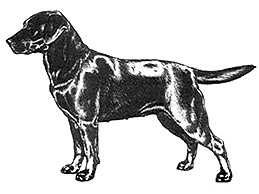FCI Standard No 122
-
Group:Group 3 (Gundogs)
- General Appearance:
Strongly built, short coupled, very active; broad in skull; broad and deep through chest and ribs; broad and strong over loins and hindquarters.
-
Characteristics:
Good tempered, very agile (which precludes excessive body weight or substance). Excellent nose, soft mouth, keen love of water. Adaptable, devoted companion.
Physical features and mental characteristics should denote a dog bred to perform as an efficient retriever of game with a stable temperament suitable for a variety of pursuits beyond the hunting environment.
-
Temperament:
Labs are loving, people oriented dogs. They are happiest when they are with you. Labs are retrievers and will bring you things they find lying about your house and yard.
They tend to be quite patient with children and wonderful family dogs. They are not guard dogs. They may bark protectively but will generally not act more aggressively.
Labs are wonderful people dogs more likely to lick someone to death than hurt them. They tend to be stable, not easily upset by strange things or occurrences. They will take many things in their stride.
The multipurpose abilities of the Labrador, indicated by their use as guide dogs, drug detector dogs, bomb detector dogs etc is the best indication of their superior stability of temperament and train ability, which of course makes them the most popular family pet. -
Head And Skull:
Skull broad with defined stop; clean cut without fleshy cheeks. Jaws of medium length, powerful not snipey. Nose wide, nostrils well-developed.
-
Eyes:
Medium size, expressing intelligence and good temper; brown or hazel.
-
Ears:
Not large or heavy, hanging close to head and set rather far back.
-
Mouth:
Jaws and teeth strong with a perfect, regular and complete scissor bite, i.e. Upper teeth closely overlapping lower teeth and set square to the jaws.
-
Neck:
Clean, strong, powerful, set into well-placed shoulders.
-
Forequarters:
Shoulders long and sloping. Forelegs well-boned and straight from elbow to ground when viewed from either front or side.
-
Body:
Chest of good width and depth, with well-sprung barrel ribs (this effect not to be produced by carrying excessive weight). Level topline. Loins wide, short-coupled and strong.
-
Hindquarters:
Well-developed not sloping to tail; well turned stifle. Hocks well let down, cowhocks highly undesirable.
-
Feet:
Round, compact; well-arched toes and well-developed pads
-
Tail:
Distinctive feature, very thick towards base, gradually tapering towards tip, medium length, free from feathering, but clothed thickly all round with short, thick, dense coat, thus giving ’rounded’ appearance described as ‘Otter’ tail. May be carried gaily but should not curl over back.
-
Gait/Movement:
Free, covering adequate ground; straight and true in front and rear.
-
Coat:
Distinctive feature, short dense without wave or feathering, giving fairly hard feel to the touch; weather resistant undercoat.
-
Colour:
Wholly black, yellow or liver/chocolate. Yellows range from light cream to red fox. Small white spot on chest permissible.
-
Sizes:
Height:
Dogs 56 – 57 cms (22-22.5 ins) at withers
Bitches 55 – 56 cms (21.5 – 22 ins) at withers
-
Faults:
Any departure from the foregoing points should be considered a fault and the seriousness with which the fault should be regarded should be in exact proportion to its degree and its effect upon the health and welfare of the dog, and on the dog’s ability to perform its traditional work.

